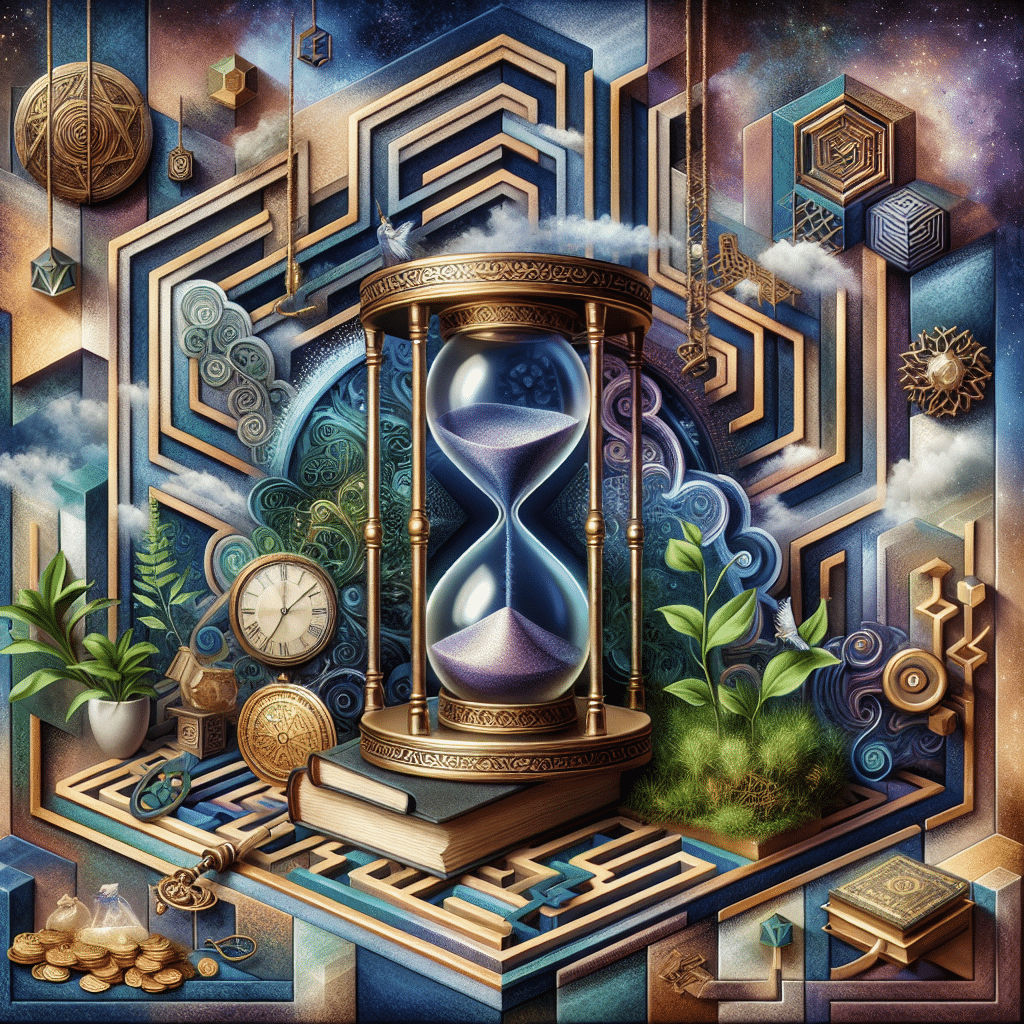-
Table of Contents
“Unlocking the Past, Shaping the Future: The Ministry of Time”
“The Ministry of Time” by Kaliane Bradley is a captivating exploration into the enigmatic world of time travel and its profound implications on history and human experience. Bradley masterfully intertwines elements of science fiction with historical intrigue, creating a narrative that delves into the complexities of temporal manipulation. The book unveils the clandestine operations of a secretive government agency tasked with safeguarding the timeline, revealing the delicate balance between past, present, and future. Through richly developed characters and intricate plotlines, “The Ministry of Time” offers readers a thought-provoking journey that challenges their perceptions of time and destiny.
Exploring The Historical Accuracy In The Ministry Of Time
“The Ministry of Time” by Kaliane Bradley – Secret to Success
Exploring The Historical Accuracy In The Ministry Of Time
“The Ministry of Time,” a Spanish television series created by Pablo and Javier Olivares, has garnered significant acclaim for its innovative approach to the time-travel genre. One of the most compelling aspects of the show is its meticulous attention to historical accuracy, which serves as a cornerstone of its success. By weaving together intricate narratives that span various epochs, the series not only entertains but also educates its audience about pivotal moments in history. This commitment to authenticity is evident in the show’s detailed portrayal of historical figures, events, and settings.
To begin with, the creators of “The Ministry of Time” have gone to great lengths to ensure that the historical contexts depicted in the series are as accurate as possible. This dedication is reflected in their collaboration with historians and experts who provide invaluable insights into the periods being portrayed. For instance, when the show delves into the Spanish Golden Age, it does so with a level of detail that captures the essence of the era. The costumes, language, and social customs are all meticulously researched, allowing viewers to immerse themselves fully in the historical milieu.
Moreover, the series excels in its portrayal of historical figures, bringing them to life with a depth and complexity that transcends mere caricature. Characters such as Diego Velázquez and Lope de Vega are not only accurately depicted in terms of their physical appearance but also in their personalities and motivations. This nuanced representation is achieved through a combination of thorough research and exceptional acting, which together create a vivid and believable portrayal of these iconic individuals. Consequently, viewers gain a deeper understanding of these figures’ contributions to history and their enduring legacies.
In addition to its focus on individual characters, “The Ministry of Time” also shines in its depiction of significant historical events. The series does not shy away from exploring complex and often controversial moments in history, such as the Spanish Inquisition or the Spanish Civil War. By presenting these events with a balanced perspective, the show encourages viewers to engage critically with history and consider multiple viewpoints. This approach not only enhances the educational value of the series but also fosters a more nuanced understanding of historical events.
Furthermore, the show’s attention to detail extends to its settings, which are recreated with remarkable accuracy. From the bustling streets of 16th-century Madrid to the opulent courts of medieval Spain, each location is meticulously designed to reflect the architectural styles and cultural norms of the time. This level of authenticity is achieved through extensive research and collaboration with experts in historical architecture and design. As a result, viewers are transported to different eras with a sense of realism that enhances their overall viewing experience.
In conclusion, “The Ministry of Time” stands out as a paragon of historical accuracy in television. Its success can be attributed to its unwavering commitment to authenticity, which is evident in its portrayal of historical figures, events, and settings. By collaborating with historians and experts, the creators have crafted a series that not only entertains but also educates its audience about important moments in history. This dedication to accuracy not only enriches the narrative but also fosters a deeper appreciation for history among viewers. As such, “The Ministry of Time” serves as a testament to the power of storytelling in bringing history to life.
Character Development And Dynamics In The Ministry Of Time
“The Ministry of Time,” a Spanish television series created by Pablo and Javier Olivares, has garnered critical acclaim and a dedicated fan base since its debut. One of the key elements contributing to its success is the intricate character development and the dynamic relationships among the characters. This aspect of the show not only enriches the narrative but also deepens the audience’s emotional investment in the story.
At the heart of “The Ministry of Time” lies a diverse ensemble of characters, each with unique backgrounds, motivations, and personal struggles. The series follows a secret government agency tasked with protecting Spain’s historical timeline from temporal intrusions. The agency’s operatives, drawn from different eras, bring their distinct perspectives and skills to the team, creating a rich tapestry of interactions and conflicts.
Julián Martínez, a 21st-century paramedic, serves as the audience’s initial point of entry into this complex world. His character arc is marked by profound personal loss and a quest for redemption. Julián’s journey is compelling because it mirrors the human experience of grappling with grief and seeking purpose. His modern sensibilities often clash with those of his colleagues from different historical periods, leading to thought-provoking discussions on morality, duty, and progress.
Amelia Folch, a pioneering 19th-century scholar, embodies the spirit of intellectual curiosity and resilience. Her character challenges the gender norms of her time, providing a powerful commentary on women’s roles in history. Amelia’s interactions with her male counterparts are particularly noteworthy; she often finds herself at odds with their outdated views, yet she consistently proves her worth through her intelligence and resourcefulness. This dynamic not only highlights the progress society has made but also underscores the ongoing struggle for gender equality.
Alonso de Entrerríos, a 16th-century soldier, brings a sense of honor and duty rooted in his era’s chivalric code. His character provides a stark contrast to Julián’s modern pragmatism and Amelia’s intellectualism. Alonso’s unwavering loyalty and martial prowess are tempered by his gradual adaptation to contemporary values and technologies. This evolution is emblematic of the broader theme of cultural exchange and adaptation that permeates the series.
The interplay between these three central characters forms the backbone of “The Ministry of Time.” Their differing worldviews create a fertile ground for conflict and collaboration, driving the narrative forward. The series deftly explores how their individual growth impacts their collective mission, illustrating that true progress often requires reconciling disparate perspectives.
Moreover, the supporting characters add further depth to the story. Salvador Martí, the enigmatic head of the Ministry, embodies the complexities of leadership in an organization tasked with safeguarding history. His decisions often place him at odds with his subordinates, revealing the moral ambiguities inherent in wielding such power. Similarly, Irene Larra, a 20th-century spy with a mysterious past, adds layers of intrigue and emotional complexity to the team dynamics.
In conclusion, “The Ministry of Time” excels in character development and dynamics by weaving together diverse personalities from different historical periods. The series’ success lies in its ability to create multi-dimensional characters whose interactions reflect broader societal themes. Through their personal journeys and evolving relationships, “The Ministry of Time” offers a compelling exploration of human nature, history, and the timeless quest for meaning and connection.
The Role Of Time Travel In Shaping The Narrative Of The Ministry Of Time
“The Ministry of Time” by Kaliane Bradley – Secret to Success
The role of time travel in shaping the narrative of “The Ministry of Time” is both intricate and profound, serving as the linchpin around which the entire series revolves. Time travel, a concept that has fascinated humanity for centuries, is deftly employed in this series to explore historical events, cultural shifts, and the very essence of human nature. By weaving time travel into the fabric of its storytelling, “The Ministry of Time” not only captivates its audience but also offers a unique lens through which to examine the past, present, and future.
At the heart of “The Ministry of Time” lies the eponymous government agency tasked with safeguarding the timeline from unauthorized alterations. This premise immediately sets the stage for a narrative that is as much about preserving history as it is about understanding it. The agency’s operatives, drawn from different historical periods, bring with them diverse perspectives and skills, enriching the narrative tapestry. Their interactions and missions underscore the series’ central theme: that history is not a static record but a dynamic continuum shaped by countless individual actions.
Time travel in “The Ministry of Time” is not merely a plot device but a narrative strategy that allows for a deep exploration of historical contexts. By sending characters back to pivotal moments in history, the series invites viewers to witness these events firsthand, thereby fostering a more intimate connection with the past. This approach also enables the series to highlight lesser-known historical figures and events, broadening the audience’s understanding of history beyond the conventional canon.
Moreover, time travel serves as a mechanism for character development within the series. As characters navigate different eras, they are confronted with moral dilemmas and ethical questions that challenge their preconceived notions. These experiences often lead to profound personal growth and transformation, adding layers of complexity to their character arcs. For instance, a character from the modern era might grapple with the social norms and injustices of a bygone age, prompting reflections on progress and continuity.
In addition to character development, time travel in “The Ministry of Time” facilitates thematic exploration. The series delves into themes such as identity, memory, and legacy, examining how individuals and societies are shaped by their histories. Through its time-traveling narrative, the series posits that understanding one’s past is crucial to navigating the present and envisioning the future. This thematic depth elevates “The Ministry of Time” beyond mere entertainment, positioning it as a thought-provoking commentary on the human condition.
Furthermore, time travel introduces an element of unpredictability and suspense to the narrative. The potential for timeline disruptions creates a constant undercurrent of tension, as characters must navigate not only their missions but also the unforeseen consequences of their actions. This narrative tension keeps viewers engaged, as they are continually reminded that even seemingly minor actions can have far-reaching implications.
In conclusion, time travel is integral to the narrative structure and thematic richness of “The Ministry of Time.” By employing time travel as both a plot mechanism and a tool for exploration, the series offers a multifaceted examination of history and humanity. It challenges viewers to consider the interconnectedness of past, present, and future while providing a compelling and immersive storytelling experience. Through its innovative use of time travel, “The Ministry of Time” achieves a delicate balance between entertainment and intellectual engagement, securing its place as a standout work in contemporary television.
Q&A
1. **What is the central theme of “The Ministry of Time” by Kaliane Bradley?**
– The central theme is the exploration of time travel and its implications on history and personal identity.
2. **Who are the main characters in the story?**
– The main characters include members of a secret government agency tasked with protecting historical events from being altered.
3. **What is the primary conflict in “The Ministry of Time”?**
– The primary conflict revolves around the agency’s efforts to prevent time-traveling adversaries from changing significant historical events, thereby preserving the timeline.”The Ministry of Time” by Kaliane Bradley highlights the importance of adaptability, teamwork, and the strategic use of historical knowledge as key elements to achieving success. The narrative underscores that understanding and leveraging the past can provide invaluable insights and advantages in navigating present and future challenges.

